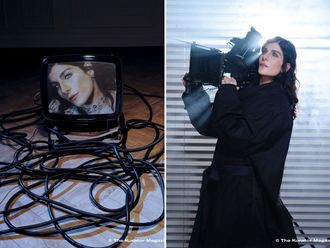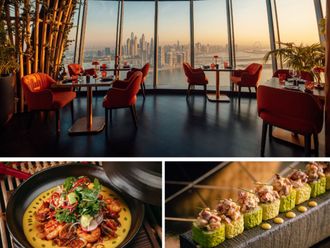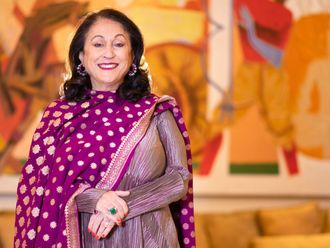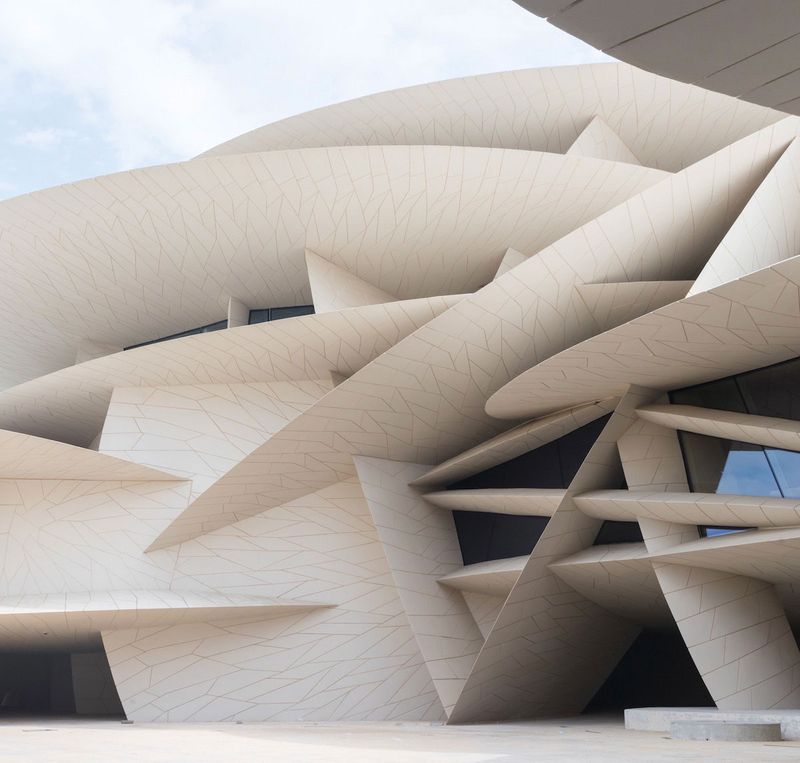
On the rise
Inside the National Museum of Qatar, the Arab state’s entire aesthetic vocabulary comes to life. Here, we speak with the Museum team about its many compelling offerings.
On the increasingly crowded global art calendar, Qatar has quickly emerged as the next essential stop. Having riveted global attention for being the first Arab state to host the FIFA World Cup, it’s poised to become a cultural epicentre and magnet for museumgoers.
With Qatar Museums (QM) spearheading the country’s robust cultural development, there has been a surge in heritage sites, festivals and art centres. Five major institutions, the Museum of Islamic Art, National Museum of Qatar (NMoQ), Mathaf: Arab Museum of Modern Art, 3-2-1 Qatar Olympic and Sports Museum, and M7 have opened since 2008. And three new spaces are scheduled to be unveiled over the next decade.
The National Museum of Qatar, an architectural tour de force envisioned as a desert rose by Pritzker Prize-winning architect Jean Nouvel, is among the cultural gems that dot the capital city of Doha. The 350-metre-long building with inward-curving discs, intersections and cantilevered elements offers a loving, lyrical essay to the history of Qatar, its native flora and fauna, and its nomadic people and their long-held traditions. Inside, Qatar’s entire aesthetic vocabulary comes to life through cultural production that offers scintillating insight into the country - then and now.
“The curatorial team conducted extensive research over the course of ten years into the themes and ideas that represent Qatar’s rich heritage and culture,” says Tania Al Majid, Acting Deputy Director of Curatorial Affairs at the NMoQ. “They worked with local and international experts in the fields of research, conservation, restoration, and protection to tell the story of Qatar’s past, present and future.”
The Museum houses a treasure trove of archaeological finds, manuscripts, maps, documents, historical photographs, textiles, jewellery, costumes, and oral histories, presented in an immersive, inclusive and multilayered way through films, models, and digital experiences.
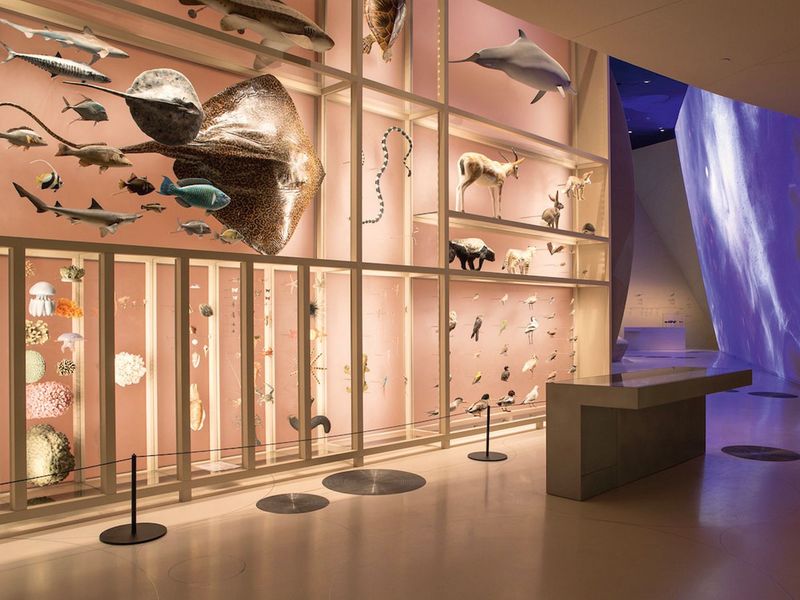
Among its ongoing exhibitions that runs until 14th January 2023 is “On The Move”, which explores the lives of nomadic and semi- nomadic peoples across three distinct regions, Qatar, Mongolia and Central Sahara. Rich with archival footage, the showcase highlights the complex cultural forms and meaningful social relationships of pastoralists, who move with the herds that they tend.
“The ‘On the Move’ exhibition brings together objects from NMoQ and QM’s collections and from local and international institutions, such as the Qatar National Library, Musée du Quai Branly, Weltmuseum Vienna, National Museum of Mongolia, National Art Gallery of Mongolia, and National Museums of World Culture in Sweden,” notes Evangelia Patmali, Human Science Exhibitions Researcher III at QM.
On view at the exhibition are historical images and footage, as well as contemporary photographs by creatives from the regions presented in the exhibition, Qatar, Mongolia and Central Sahara. “It also includes fieldwork material by other curators and anthropologists. All this content was carefully selected through a thorough process of research in bibliography, fieldwork, archives and collections conducted by the curators to correspond with the narratives of each section,” explains Evangelia. “Overall, the objects, photographs and audio-visual materials highlight the richness and meaningfulness of the lives lived by the groups discussed in the exhibition.”
A centerpiece at NMoQ is the Central Midkhan by Qatari artist Aisha Nasser Al Sowaidi. Located in the VIP lounge, it reimagines the concept of a home’s internal infrastructure and offers a remarkable confluence of traditional artefacts and contemporary functionality.
Nodding to industrial design, it distributes scent in multiple directions and when not in use, serves as a visual marvel that will stop you in your tracks. “There’s a ritual surrounding the activities of the majlis that began centuries ago and still exist today, translating easily from the desert encampments to urban houses,” says Bouthayna Baltaji, Acting Head of Exhibitions and the Heritage Exhibit section at NMoQ, referencing the Central Midkhan.
“The process of greeting guests, serving tea and coffee, providing meals and burning incense are some of the activities integral to a majlis. Incense burners were used in the majlis for special occasions, as they were a luxury item. The smell of a’oud (sandalwood incense) and the flavour of qahwa are very much evocative of the majlis and are the mark of a good and generous host.” Bouthayna adds, “In the words of the artist, ‘Adapting with the idea of home systems, the Central Midkhan is designed to distribute the scent into more than one direction and place. This installation takes the idea of a traditional and local ritual into a global concept of home systems’.”
With an influx of visitors in the wake of the World Cup, there’s much to relish in Doha other than football. “The National Museum features eleven permanent galleries that present the history of the nation through interactive and engaging exhibits that include large-scale art films projected onto gallery walls, oral histories, in-depth exhibits that present a deeper layer of content related to the gallery, a children’s mode option and scent feature, and family exhibit spaces that encourage intergenerational learning experiences,” shares Bouthayna.
The permanent gallery journey ends with the visitors entering the Old Palace, the former residence of Sheikh Abdullah Bin Jassim Al Thani. This historic landmark has been restored and refurbished several times since its construction in 1906 and was home to the former National Museum. The Museum also features three playgrounds: the Cave of Wonders that’s inspired by real dahls or grottos found in Qatar; the Adventure Ship; and the Qatar Total Energies Playground, which is opening in early December.
“The playgrounds take inspiration from the narratives presented in the permanent galleries,” states Bouthayna. “They draw on the idea of intergenerational learning practices and aim to familiarize younger audiences with objects they’ll see during their visit inside the museum.”
The space also had temporary exhibitions available to the public during the World Cup. One looks at mental health related matters, titled “Pipilotti Rist: Your Brain to Me, My Brain to You”, and the other is “On the Move”. The space is also home to the Mawater Gallery, which presents car exhibitions curated by the soon to open Qatar Auto Museum. A series of compelling temporary exhibitions will also be showcased over the coming years. “Our thematic exhibitions seek to engage the public and expand the stories of the permanent galleries,” shares Bouthayna. “They’re experiences that celebrate Qatar’s unique culture and diverse communities, as well as the country’s relationship with other cultures. The temporary exhibitions further activate and connect our audiences with the museum and country’s public spaces. Innovative interactive exhibits and storytelling techniques provide a multitude of interpretative messaging opportunities, which are intended to act as informal learning spaces that reflect on the country’s rich history and cross cultural ties.”
Combining fine artisanship with creative ingenuity and operational delight, Qatar’s deeply contemplative museum offerings indicate that its future holds great cultural promise.
Captions:
1) Five major institutions, the Museum of Islamic Art, National Museum of Qatar (NMoQ), Mathaf: Arab Museum of Modern Art, 3-2-1 Qatar Olympic and Sports Museum, and M7 have opened since 2008. Image credit: supplied
2) The Museum houses a treasure trove of archaeological finds, manuscripts, maps, documents, jewellery, costumes, and more. Image credit: supplied


